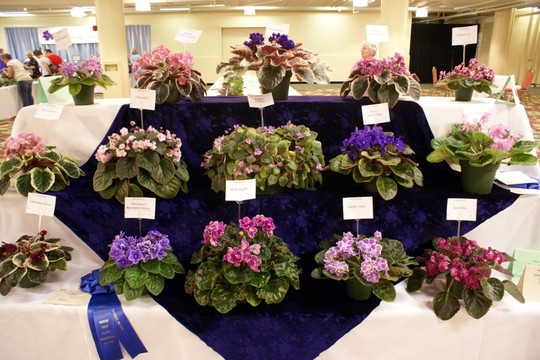Plant profile: African Violets
Photo courtesy of @sillappeal on Instagram.
I’ll admit, I’ve been bitten by the African Violet bug. They weren’t even on my radar a year ago, as I was intimidated by them. I’d always heard they were difficult to care for and fussy. I kept one 6 years ago and killed it after a few months - now I realize I had it in light that was much too low and let it dry out too long! You live and learn! Anyway, I picked up another AV last November, and was determined to keep it alive. My grandma - who I got my green thumb from - kept a few beautiful African Violets and they were almost always in bloom. I wanted to keep my AV alive in honor of my grandma who passed 10 years ago. That African Violet turned out to be one of the easiest, most chill plants I own, and is constantly in bloom. I now have a nice little collection and can’t wait to expand more in the spring! I even got a membership to the African Violet Society of America and can’t wait to go to a meeting at my local African Violet club.
I wrote this guide as a general care guide, for the every day African Violet grower & newbies. There is an entire world of showing African Violets, like you would show purebred dogs, but for plants. It’s an art and science of growing the AV’s for show, making sure there is a certain shape and symmetry to the plant, with a certain amount of blooms. Google African Violet shows and you’ll see some of what I’m talking about! I’m not that professional about my AV’s and don’t mind if they grow a little wild and free.
I also want to give a huge thanks and shoutout to my Instagram plant friend + fellow AV addict, @sillappeal! She let me use some of her gorgeous African Violet photos!
An example of some African Violets for show! Image from Google.
History + biology: African Violets hail from the country in Africa now known as Tanzania, and were discovered by Baron Walter von Saint Paul-Illaire, for whom their genus Saintpaulia is named for. Their flowers bear a resemblance to common violets, hence the colloquial name! While there are only around 20 true species of Saintpaulia, there are over 5,000 hyrbids and cultivars, with all sorts of colors and shapes. Above I talked about how I thought AV’s were hard to grow, and the original species do tend to be very demanding. However, I have only hyrbids and most of what you’ll find at the garden center are hybrids. The hyrbids are much more free-blooming and easy to keep.
African Violets have been extremely popular houseplants since they appeared on the market in the 1920s, because they are so easy to keep, fit neatly on a windowsill, and are almost always in bloom. With so many varieties, you’re bound to find something that strikes your fancy. There are many sizes from micro-minature (3” in diameter) to large (16” or more), leaf colors and shapes (even some variegated!), and different shapes and colors of flowers. With proper care, African Violets can live for over 50 years!
I learned recently that African Violets went through a botanical revision in 2015 and their genus changed from Saintpaulia to Streptocarpus sect. Saintpaulia. Genetic testing was done and showed they are part of the larger Streptocarpus genus. For more information, read an article here at the Gesneriad Reference Web and The Laidback Gardener (one of my favorite plant blogs!).
Lighting: African Violets all do well in bright, indirect light. They’re also perfect office plants as they thrive under fluorescent lighting. I personally keep mine in an east-facing window (northern hemisphere). I’ve kept them right in north-facing windows as well, and they bloom just fine, but the flower color isn’t as intense as it would be in brighter light. AV’s will do fine in west and south windows, too, just make sure to protect them from harsh sun. A sheer curtain will work wonders for filtering any hot rays!
Watering: Watering seems to be the trickiest part for many new African Violet parents. It’s important to use tepid/lukewarm water, as any cold water left on leaves can leaves brown spots. In fact, any water left on leaves in bright light can cause spotting, so many AV growers water from the bottom. AV’s need to be kept lightly moist at all times, and should never be left to dry out. I personally LOVE to use self-watering pots where you fill a basin with water and place the pot inside of it. I refill the basin about every 2 weeks and the plants grow beautifully. Sometimes the self-watering pots can get expensive if you have more than a few, so the wicking method is a great option.
According to the AVSA: “The wicking method of watering involves stringing a wick made of man-made fiber (such as rayon cording or acrylic yarn) through the potting mix so that it dangles out the bottom of the pot. The plant is then set above a reservoir of water so that the bottom end of the wick is in the water. The wick then draws water out of the reservoir and into the potting mix using capillary action.” Check out the AVSA site for more on the wicking method!
Photo courtesy of @sillappeal on Instagram.
Humidity + temperature: African Violets are suited to the home since they acclimate well to standard household humidity. If your environment is particularly dry, you may want to use a humidifier nearby, but make sure any mist doesn’t touch the leaves, as it could cause brown spots. You can also pack moist spaghum moss around the base of the plant or make a pebble tray. In terms of temperatures, AV’s love an average room temp. In the winter, keep temperatures above 60 degrees F, and keep away from cold draughts. This warmth is absolutely essential to good growing! Also make sure to keep the leaves from touching a windowpane, which can get quite hot or cold depending on the season.
Photo courtesy of @sillappeal on Instagram.
Soil + fertilizer: A peat-based potting mix that holds onto moisture is the best option for African Violets! I usually just buy African Violet potting mix, which is specially formulated just for AV’s. I love the Epsoma brand, which you can find at any local nursery and on Amazon. Most mixes on the market don’t have enough drainage for my taste, so I always add a large handful of perlite to the AV potting soil.
You can use any high-phosphorus fertilizer once a month, and every two weeks when blooming. I find the Shultz brand quite good.
Photo courtesy of @sillappeal on Instagram.
Repotting + pruning: African Violets will almost never need a pot larger than 6” in diameter, so repotting often isn’t necessary. However, it’s advised that growers refresh the soil yearly (usually in spring) and trim roots if need be, setting the plant slightly lower in the pot.
In terms of basic pruning - that is, if you’re not showing African Violets - remove dead flowers and damaged leaves as soon as you find them, don’t leave a stalk. Older plants will produce offsets or shoots known as “suckers” which should be removed and can be propagated!
Photo courtesy of @sillappeal on Instagram.
Flowering: Most mature specimens (species and hybrids alike) bloom freely, even in the colder months. The most important aspect to keep your AV flowering is BRIGHT diffused/indirect light, or even a grow light. They do well under most fluorescent lights. Also keep the African Violet in a smaller pot as stated above, with evenly moist soil. I’ve noticed my AV’s are less likely to bloom in all the right conditions if I allow the soil to dry out for too long. Additionally, try using a fertilizer specifically formulated for encouraging blooms.
Propagation: African Violets propagate easily with leaf cuttings (all that’s needed is a bit of stem) or through separating suckers/plantlets.
Common problems: Brown spots (usually from cold water sitting on leaves or from being exposed to colder temps), yellowing leaves (overwatering or nutrient deficiencies), crown rot (due to watering from the top), no flowers (see above). African Violets are also susceptible to powdery mildew and mealybugs.
Photo courtesy of @sillappeal on Instagram.









